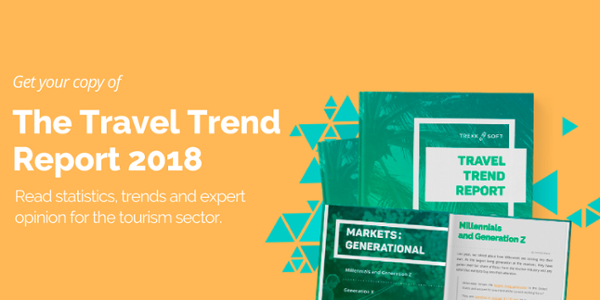In our 2018 Travel Trends Report, we published an extensive chapter on sustainability and the challenges the industry faced in the summer of 2017. I highlight the need for governments, destinations and corporations to include the voice of the “common man”, these are locals who walk past tourists, talk to tourists, help them when they’re lost, rent apartments to tourists, serve tourists and clean up after tourists every single day.

Engaging "the common man" to plan for growing traveller demand
At the 2017 UNWTO & WTM Ministers' Summit in London, I learned that in preparation for the 2020 Olympic and Paralympic games, the Japanese government is relying on big data to understand traveller behaviour in popular destinations like Tokyo, Kyoto and Osaka, and will use those insights to inform their plans to develop destinations to meet the growing travel demand.
In a report by McKinsey on Japan's plans to manage future demand, they highlight two issues that need to be addressed before overtourism becomes an issue in major Japanese destinations.
The first is a lack of awareness of Japanese tourism assets, even amongst repeat visitors. The report noted that only 11% of repeat visitors were aware of Japan's non-metropolitan destinations, whilst less than 10% of Asian tourists (Japan's largest inbound market) are aware of it.
Another problem noted in the report is the limited service model in local regions where there's little differentiation between main Japanese tourism assets: nature, culture, beach, entertainment, and shopping. Furthermore, there's also a general lack of promotional activities for lesser known destinations, and a lack of infrastructure online and in English. It's also no surprise that there's a lack of resource and capabilities for less popular destinations to improve in these areas.
What is needed here, according to the report, is public and government partnerships to grow lesser known destinations and enhance the end-to-end customer journey.

What can tour and activity operators take away from these insights?
If you notice a similar pattern in your destination, where there are too many tourists in peak seasons and very little throughout the rest of the year, where there are well known destinations locally but foreign travellers have never heard of them, where there's an abundance of opportunities for local communities to benefit from but the effects are not trickling down - what can you do? More importantly, what can you do given time, capability and resource constraints?
- If you're located outside a major tourist hot spot, can you partner with hotels and hostels in major destinations to promote your activities?
- Can you create trips that are attractive enough to lure travellers to your destination?
- If there's a problem with transport and connectivity, can you write a blog post or guide online that helps travellers get to your destination? Can you recommend good car rental providers or transfer services for more adventurous travellers?
- Can you include an educational element in your tours or activities about social issues that matter to your community?
- Can you draw on experiences your destination has and use that in your marketing and branding?
Read more: Destination marketing handbook for DMOs, DMCs and visitor bureaus
Success stories from Greece: Spreading demand throughout the year
In Greece, I learned that the country has successfully marketed itself as a year-long travel destinations to prolong the high season and spread out the demand beyond the summer months. The country's tourism minister recounted the effort it took to convince local accommodation providers to stay open all year long while regional destination companies worked with local operators to innovate and create products that aren’t dependant on the summer seasons.
Success stories from Fjord Norway: Spreading the demand to small towns and less popular destinations
We also found a similar narrative in Fjord Norway. The destination understood that their peak seasons put a strain on locals and are working closely with local operators to encourage more visits throughout the winter months, where the destination becomes a paradise for winter sports. The DMO also built a supplier network and connected operators near and far, allowing travellers to learn about the different experiences available throughout the region from browsing through the Fjord Norway website. This layer of connectivity also connects operators to one another, allowing them to cross-sell each others' services or work together to sell interesting packages.
Insights from Wouter Geerts, senior research analyst at Euromonitor International
In my conversation with Wouter Geerts, a senior research analyst at Euromonitor, he made it clear that it is still difficult for tour and activity operators to be engaged in a global way because the tour and activity sector is so fragmented and "hyperlocal".
While local operators have the opportunity to shape the global perception of their destination, the converse also holds true - "One bad apple can do serious damage to a local site, even when all other tour operators are following a sustainability code of conduct."
Personally, I think that for destinations that don’t have a destination management company to play the role of the coordinator, it will be up to local operators to take up the challenge. It will be up to companies to call each other out on bad practices and challenge each other to do better. The future of sustainability will have to be a grassroots movement, and with technology, it’s a lot easier to do that.
From what I’ve read and heard around sustainability, I’ve yet to see on-the-ground operators be engaged globally, and to some extent that makes a lot of sense. Since each destination is unique and different and special in its own way, a one-size-fits-all solution is doomed to fail.
In closing, I would like to highlight the brilliant words of Anna Pollock, founder of Conscious Travel: “Tourism is an extractive system that consumes physical space and human patience. Both are finite – albeit subjectively so. Easy to sense if you use your heart and soul [but] fiendishly difficult to quantify!”
Learn more about sustainability and overtourism in our 2018 Travel Trends Report.




